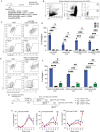This is a preprint.
Vaccine-induced antigen archiving enhances local memory CD8+ T cell responses following an unrelated viral infection
- PMID: 37841845
- PMCID: PMC10571600
- DOI: 10.21203/rs.3.rs-3307809/v1
Vaccine-induced antigen archiving enhances local memory CD8+ T cell responses following an unrelated viral infection
Update in
-
Immunization-induced antigen archiving enhances local memory CD8+ T cell responses following an unrelated viral infection.NPJ Vaccines. 2024 Mar 21;9(1):66. doi: 10.1038/s41541-024-00856-6. NPJ Vaccines. 2024. PMID: 38514656 Free PMC article.
Abstract
Viral and vaccine antigens persist or are archived in lymph node stromal cells (LNSC) such as lymphatic endothelial cells (LEC) and fibroblastic reticular cells (FRC). Here, we find that, during the time frame of antigen archiving, LEC apoptosis caused by a second, but unrelated, innate immune stimulus such as vaccina viral infection or CpG DNA administration boosted memory CD8+ T cells specific to the archived antigen. In contrast to "bystander" activation associated with unrelated infections, the memory CD8+ T cells specific to the vaccine archived antigen were significantly higher than memory CD8+ T cells of a different antigen specificity. Finally, the boosted memory CD8+ T cells resulted in increased protection against Listeria monocytogenes expressing the vaccine antigen, but only for the duration that the vaccine antigen was archived. These findings outline a novel mechanism by which LNSC archived antigens, in addition to bystander activation, can augment memory CD8+ T cell responses during repeated inflammatory insults.
Keywords: CD8 T cell; antigen archiving; bystander activation; lymph node; lymph node stromal cell; protection.
Conflict of interest statement
CONFLICT OF INTEREST We declare no competing interest.
Figures





Similar articles
-
Immunization-induced antigen archiving enhances local memory CD8+ T cell responses following an unrelated viral infection.NPJ Vaccines. 2024 Mar 21;9(1):66. doi: 10.1038/s41541-024-00856-6. NPJ Vaccines. 2024. PMID: 38514656 Free PMC article.
-
Antigen-dependent and -independent contributions to primary memory CD8 T cell activation and protection following infection.Sci Rep. 2015 Dec 10;5:18022. doi: 10.1038/srep18022. Sci Rep. 2015. PMID: 26658291 Free PMC article.
-
Antigen capture and archiving by lymphatic endothelial cells following vaccination or viral infection.Nat Commun. 2014 Jun 6;5:3989. doi: 10.1038/ncomms4989. Nat Commun. 2014. PMID: 24905362 Free PMC article.
-
Antigen archiving by lymph node stroma: A novel function for the lymphatic endothelium.Eur J Immunol. 2015 Oct;45(10):2721-9. doi: 10.1002/eji.201545739. Epub 2015 Sep 10. Eur J Immunol. 2015. PMID: 26278423 Free PMC article. Review.
-
Bystander activation in memory and antigen-inexperienced memory-like CD8 T cells.Curr Opin Immunol. 2023 Jun;82:102299. doi: 10.1016/j.coi.2023.102299. Epub 2023 Mar 11. Curr Opin Immunol. 2023. PMID: 36913776 Review.
References
-
- Wilson D.B. et al. Specificity and degeneracy of T cells. Mol Immunol 40, 1047–1055 (2004). - PubMed
-
- Nikolich-Zugich J., Slifka M.K. & Messaoudi I. The many important facets of T-cell repertoire diversity. Nat Rev Immunol 4, 123–132 (2004). - PubMed
-
- Long Q.X. et al. Clinical and immunological assessment of asymptomatic SARS-CoV-2 infections. Nat Med 26, 1200–1204 (2020). - PubMed
Publication types
Grants and funding
LinkOut - more resources
Full Text Sources
Research Materials

